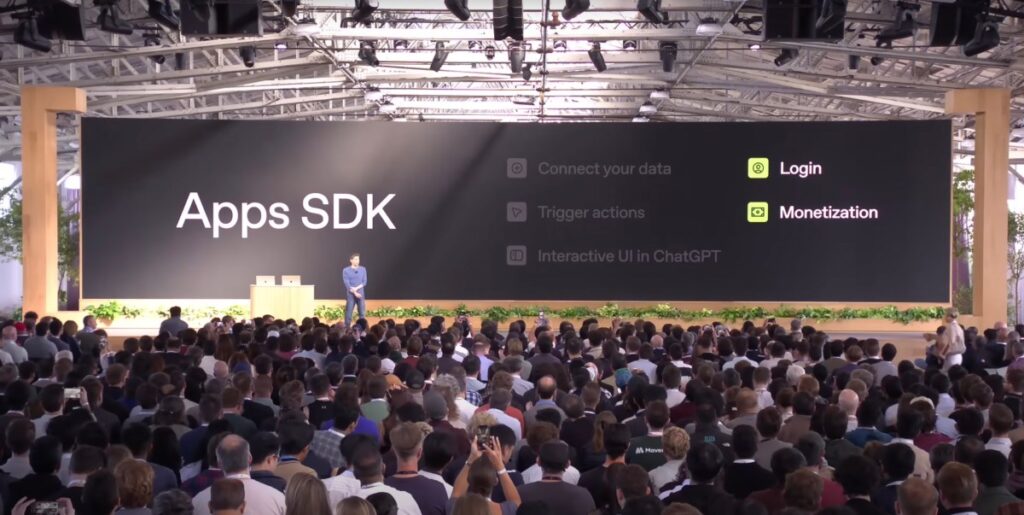OpenAI held its annual dev day on Monday, where the company rolled out its plan to build apps into ChatGPT. The demo was impressive, showing how programs like Spotify and Figma can be called or discovered without leaving the ChatGPT window. With so much of the tech world barreling towards AI integration, OpenAI’s demo was the best picture yet of what an AI-first internet might actually look like, with interfaces like ChatGPT querying information and executing commands directly.
If you’re watching closely, you may have noticed that there’s a lot of room in this system for money to change hands. Just last week, the company launched Instant Checkout, an agentic shopping system that serves as payment infrastructure for one-off purchases, plugging in any stores that sell through Shopify, Etsy or Stripe. Now, apps provides the front-end infrastructure, letting service providers build their own interface into ChatGPT.
In short, OpenAI now has all the pieces in place for AI-driven commerce, establishing ChatGPT as a place customers go to buy and retailers go to sell. It’s a huge new line of business for the company — and one with huge implications for the tech industry. In this world, OpenAI’s isn’t just competing with Google and Anthropic, but with Amazon and Wal-Mart.
If you look at OpenAI’s pending app partners in the launch announcement, you can see how far the vision reaches. ChatGPT will be able to call you a cab through Uber, book a trip on Expedia, call a plumber or locksmith through Thumbtack, order groceries from Instacart, prepared food from Doordash, or big-box goods from Target. Without too much more work, ChatGPT could become a portal for most of its users’ discretionary spending.
If it works, this would be worth a lot more than just a $20-a-month subscription. The precise terms of the arrangement are still unclear, but like any app store, OpenAI is well positioned to get a portion of any money spent on its platform. ChatGPT is also recommending products, drawing on its wealth of data about its users, which tips the balance of power between OpenAI and retailers even more. In Ben Thompson’s terms, ChatGPT becomes a super-aggregator, funneling customers to retailers and providing an entry point for ever-larger amounts of commerce. OpenAI has lots of potential lines of business to pursue, but it’s no exaggeration to say that AI-driven commerce is one of the most lucrative options.
OpenAI isn’t the only company with an eye on this prospect. On the same day as the ChatGPT announcement, Adobe released a report predicting that this year’s holiday would be dominated by AI-assisted shopping, with shoppers turning to chatbots instead of search engines to find the best deals available. A separate report from Mastercard dubbed agentic commerce as a “new competitive arena” for finance. Google has already launched its own competing protocol for agentic commerce called AP2, which arrives with a broader scope but less momentum than OpenAI’s version.
The simplest version of AI-driven shopping is using ChatGPT to find products in place of search: if you’re looking for a canvas tennis shoe under $80, ChatGPT can find it for you just as easily as Google Search. But AI systems don’t need to be passive. The AP2 specification includes a provision for agent-initiated purchases, if you want an agent to buy concert tickets as soon as they become available, say, or book a flight as soon as it falls below a certain price. Of course, there could be agents on the other side of the transaction too, negotiating with purchasing agents for the best deal, and willing to bundle goods under the right circumstances. If retailers and customers are willing to take the leap, the changes could extend pretty far beyond a simple “buy” button.
Techcrunch event
San Francisco
|
October 27-29, 2025
The biggest unanswered question is whether the shopping public will actually be interested. AI shopping is obviously attractive to OpenAI, and companies like Stripe and Mastercard see plenty of benefit in it too — but users haven’t shown much interest in agentic shopping systems beyond simple product searches. But then, they haven’t had a chance to; these systems aren’t even properly available now, and it will be months before the average user can try out a fully agentic shopping system.
When they finally do, there will be a lot riding on how they react.

